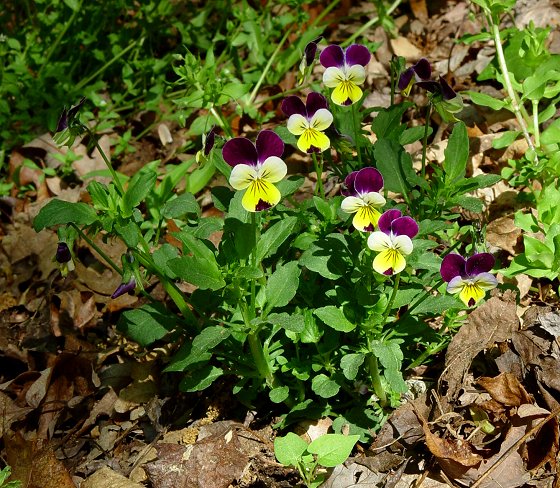Viola tricolor L.
Miniature Pansy

Introduced
CC = *
CW = 5
MOC = 7
© DETenaglia
Viola tricolor L.Miniature Pansy | |
 |
Introduced CC = * CW = 5 MOC = 7 |
© DETenaglia |
|
Family - Violaceae Habit - Annual forb with a slender, vertical taproot 1-3 mm thick. Stems - Ascending to erect, to 35 cm long, often from a spreading base. Leaves - Alternate and basal, subsessile to long-petiolate, simple, stipulate. Petioles glabrous. Stipules relatively large and leaflike, free from the petiole, deeply lobed with a fringe of several, long, linear or oblong-lanceolate segments on each side, the terminal segment much longer and broader than lateral ones, with 3 or more pairs of shallow, blunt or rounded teeth along the margins. Leaf blades 0.5-2.5 cm long, unlobed, obspatulate to nearly circular, rounded or angled to a bluntly or sharply pointed tip, narrowly angled to truncate at the base, the margins otherwise with 3 or more pairs of blunt or rounded teeth, the surfaces glabrous.
Inflorescences - Cleistogamous flowers not produced. Flower borne singly on stalks, these only slightly overtopping the leaves. Flowers - Sepals 5-14 mm long, lanceolate, angled to a sharply pointed tip, the margins glabrous, the basal auricles well-developed. Corollas 10-25 mm long, appearing strongly frontally flattened in life, the petals longer than the sepals, yellowish orange to purple on the same flower, the upper petals commonly tinged or tipped with dark blue, the lateral and lower petals often with darker veins or dark purple lines, with a yellow throat (this usually best developed on the lower petal), the lateral petals bearded on the upper surface with mostly knob-shaped hairs, the lowermost petal glabrous on the upper surface, the spur 1-2 mm long, well-exserted beyond the sepal auricles, relatively stout. Stamens not exserted, typically not visible without dissection of the flower. Style enlarged into a globose, hollow stigmatic tip.
Fruits - Capsules 6-10 mm long, broadly ellipsoid, green, drying to tan, the surface glabrous. Seeds 1.5-1.7 mm long, tan. Flowering - April - May. Habitat - Cultivated, rarely escaped to lawns, railroads, open disturbed areas. Origin - Native to Europe. Other info. - This violet is quite colorful and is one of the parent species of the commonly cultivated "pansy." This species is rarely found wild in the state, and wild populations are generally uncommon throughout the continental U.S. It is most often found in cultivation. It requires little care once established and will re-seed itself year after year. Photographs taken in Brown Summit, NC., 4-23-03 (DETenaglia). |